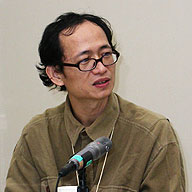An Interview with Huang Ting-fu
In the Country of Taiwan, People’s Anxiety toward the Future
Q: Does the title have some special meaning?
HT: At first I was considering titles like Skin and Rakan of Ryuzan Temple, but because of various circumstances I reconsidered and decided to put together the name of the Buddhist sutra Zhi yue lu (literally meaning “finger moon record”) and the final scene with the fingernail. But the title is nothing more than a single symbol or word. I wanted viewers to freely expand their own conjectures, without being limited to a single image.

Q: What were your intentions when shooting the memorable sequence with the fingernail in the second half of the film?
HT: The nail wasn’t that important when I was dealing with the raw footage, but as I did more editing it gradually gained prominence. I used a close up to show that this film is just a single “work,” not “reality.” The nail is simply one example. I think the inner state and emotional workings of a person are revealed within minor actions we usually aren’t conscious of, like scratching your skin or bending your finger.
Q: Are the worries and anxieties of the people you depicted deeply related to the environment engulfing people in contemporary Taiwan?
HT: In Taiwan over the past decade there’s been political turmoil about efforts to secure national status in international society, and the oppositional relationship continues between those advocating independence and those for unity with the mainland. In the midst of everything, people are feeling a lot of anxiety and impatience about this country’s future. People get excited, riled up over minor things. Long-term consideration about the future is lacking, seen both in people’s mental state and the appearance of the city with construction projects. Even with issues of national sovereignty, people are swayed back and forth by the mainland’s right to speak, and deciding things for themselves doesn’t go like they expect. Taiwan’s instability is deeply rooted with a history of rulers changing one after another over the past fifty years.
I filmed many elderly people of course because they gather at the temple, and also because I think the elderly have an existence where they can’t think about and envision the future. I selected them thinking anxiety about the future is the biggest of all the worries that humans face, and this overlaps with the impatience and anxiety that Taiwan is dealing with right now.
Q: There were many memorable things in the film, like the images of elderly people, the arrangement of sound fragments representative of contemporary media, and the shots of willows and groups of ants.
HT: The sounds I used symbolize the conditions of contemporary society. Elderly people shunted from society might not hear sounds like these, but in reality that is where it’s at, and I wanted to express the circumstances of people caught up in that sound by layering them both together. Also, I wanted to create an impression of the elderly people’s quietude contrasted with the vitality in ants and living creatures wriggling with life.
Q: What is your next work?
HT: It’s a documentary about young girls who sell areca (a nut that turns your mouth red when you chew). It’s 35mm with a surrealist style. I want to show the tendency in contemporary Taiwan of taking extreme methods with a short-term perspective through the young girls who wear scanty clothing to lure customers, trying to earn as much money as possible in the shortest amount of time. Also, it will probably treat the subject of how people behave in spatially limited circumstances, similar to my other pieces to date.
(Compiled by Hata Ayumi)
Interviewers: Hata Ayumi, Mikoshiba Kazuo / Interpreter: Akiyama Tamako
Photography: Endo Nao / Video: Matsunaga Yoshiyuki / 2003-10-11
